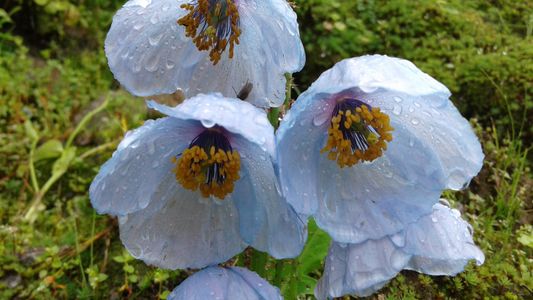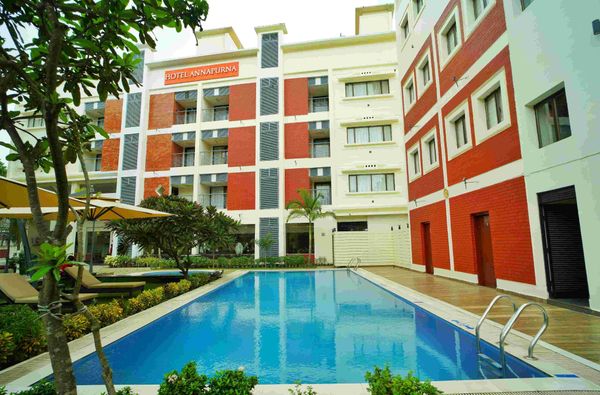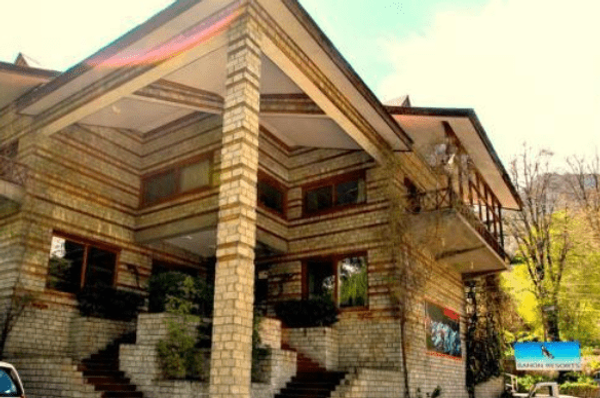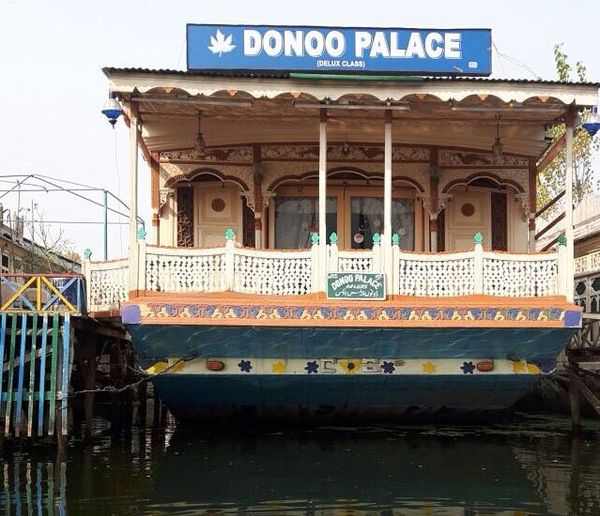Himalayan Blue Poppy: Nature’s Delicate Jewel
 Mountains Curve
26 Jul, 2025
10 mins read
10
Mountains Curve
26 Jul, 2025
10 mins read
10

The Himalayan Blue Poppy (Meconopsis betonicifolia) is a rare botanical wonder that has fascinated gardeners, botanists, and flower enthusiasts for over a century. With its ethereal, sky-blue petals and delicate structure, this elusive flower stands as a symbol of tranquility, mystery, and high-altitude resilience. Native to the misty meadows and mountainous regions of the eastern Himalayas, the Himalayan Blue Poppy is not just a flower—it’s a dream for many who seek to cultivate or even catch a glimpse of its fragile beauty.
1. Botanical Background and Taxonomy
The Himalayan Blue Poppy belongs to the Papaveraceae family, which includes poppies. Its scientific name is Meconopsis betonicifolia, though it is often confused with Meconopsis baileyi, a closely related species. These perennial plants are primarily native to Tibet, Bhutan, and northeastern India, particularly the Arunachal Pradesh region, where they grow at elevations of 10,000 to 13,000 feet.
The term Meconopsis means “poppy-like,†and rightly so—the plant bears large, papery petals with a bright yellow center, much like common poppies. What sets it apart, however, is its brilliant blue hue, a color that is exceedingly rare in the plant world.
2. Physical Description
A fully bloomed Himalayan Blue Poppy is a sight to behold:
- Height: It can reach up to 3-4 feet tall in favorable conditions.
- Flowers: The petals are broad, silky, and vivid blue, often with tinges of violet or lavender. Some variants may show hues of purple or white.
- Foliage: The leaves are large, hairy, and lance-shaped, arranged in a basal rosette.
- Blooming Season: Typically blooms in late spring to early summer (May to July), depending on altitude and local climate.
Its visual appeal, combined with its rarity, has earned the Himalayan Blue Poppy a place of prestige in botanical gardens around the world.
3. Ecological Habitat
These flowers naturally occur in cool, damp, and shaded alpine environments. They thrive in:
- Moist, well-drained, humus-rich soils
- High altitudes with cooler temperatures
- Misty and cloudy conditions with indirect sunlight
- Slopes and valleys that are protected from harsh wind
The harsh climate of the Himalayas—cold nights, intense sunlight, and heavy rains—has shaped the evolution of the blue poppy, making it hardy in some ways and incredibly delicate in others.
4. Cultivation and Growing Challenges
Growing the Himalayan Blue Poppy outside its native range, especially in lowland or warmer regions, is notoriously difficult. Gardeners in the UK and Pacific Northwest (USA and Canada) have had the most success due to their temperate climates.
Key Growing Requirements:
- Soil: Rich in organic matter, slightly acidic (pH 5.5–6.5)
- Watering: Regular, consistent moisture is key—but avoid waterlogging
- Temperature: Cool summers, cold winters; excessive heat causes stress
- Shade: Partial shade is essential; too much sun can scorch the leaves
Common Challenges:
- Short Lifespan: Many species are monocarpic (they die after flowering once)
- Root Rot: Due to poor drainage or fungal infections
- Slug and Snail Damage: Tender leaves are prone to pest attacks
- Seed Germination: Difficult, as seeds need cold stratification and careful temperature control
For many, cultivating this flower is a labor of love—a test of patience, precision, and passion.
5. Cultural and Symbolic Significance
The Himalayan Blue Poppy holds various symbolic meanings across cultures:
- Tibetan and Buddhist Culture: In Tibetan Buddhism, blue flowers often symbolize spiritual insight, wisdom, and enlightenment.
- Western Romanticism: In literature and art, it is seen as a symbol of unattainable dreams and elusive beauty.
- Gardening Community: Among horticulturists, successfully growing a Himalayan Blue Poppy is considered a badge of honor due to its rarity and difficulty.
In addition to its symbolic weight, it has inspired countless poems, paintings, and even perfumes aimed at capturing its ethereal fragrance and beauty.
6. Discovery and History
The plant was first introduced to Western horticulture in the early 20th century by George Forrest, a Scottish botanist and plant hunter. During his expeditions to Yunnan and Tibet, he collected seeds of the blue poppy and introduced them to the Royal Botanic Garden Edinburgh around 1912.
It quickly gained attention as one of the most beautiful and unusual flowers ever seen in Europe. Botanical institutions began studying its genetic traits, and breeders started working on creating hybrids that could be grown in more temperate climates.
7. Variants and Hybrid Species
Over the years, plant breeders have developed several hybrid varieties and cultivars to improve the flower’s adaptability:
- ‘Lingholm’: Known for its vigor and larger blooms
- ‘Alba’: A rare white variant
- ‘Slieve Donard’: A hybrid with a longer blooming period
Despite these efforts, most hybrids still require cool and moist climates and remain a challenge for gardeners.
8. Conservation Status and Threats
As a wildflower endemic to high altitudes, the Himalayan Blue Poppy is susceptible to:
- Climate Change: Rising temperatures may alter its native habitat
- Overharvesting: For ornamental use and botanical collections
- Habitat Loss: Due to human encroachment, road construction, and tourism
While it is not currently classified as endangered globally, local populations are at risk. Conservationists are advocating for protected zones and sustainable seed collection to preserve the species in its natural habitat.
9. The Allure of Blue
Why is blue so captivating in flowers?
In the natural world, blue pigmentation is rare because true blue pigments are hard to produce biochemically. Many “blue†flowers are actually purple or violet when closely examined. The Himalayan Blue Poppy’s nearly true-blue coloration is therefore an optical and biological marvel.
This makes the flower even more prized among gardeners and botanists alike. Its color is not only aesthetically striking—it also represents the mysterious complexity of plant evolution.
10. Himalayan Blue Poppy in Modern Horticulture
Today, the Himalayan Blue Poppy is a highlight in:
- Botanical gardens across Europe, Japan, and North America
- Flower shows, where it often garners awards and attention
- Private collections, especially among alpine plant enthusiasts
Institutions like the Royal Botanic Garden Edinburgh and Himalayan Botanic Garden in Nainital, India are actively involved in cultivating and studying the plant. Its continued presence in these settings helps raise awareness about high-altitude biodiversity and conservation.
Conclusion
The Himalayan Blue Poppy is more than just a flower—it’s a living expression of the Himalayan mystique. Its delicate beauty, rare coloration, and challenging cultivation have made it a botanical treasure and a symbol of perseverance in the face of natural adversity.
Whether blooming in the wild meadows of Arunachal Pradesh or under careful nurture in a European conservatory, the Himalayan Blue Poppy remains a poetic reminder that some of nature’s most stunning creations are also the most elusive. In a world constantly searching for beauty, the blue poppy quietly blooms where few dare to reach.
Written By:
Mountains Curve



Hotels at your convenience
Now choose your stay according to your preference. From finding a place for your dream destination or a mere weekend getaway to business accommodations or brief stay, we have got you covered. Explore hotels as per your mood.


